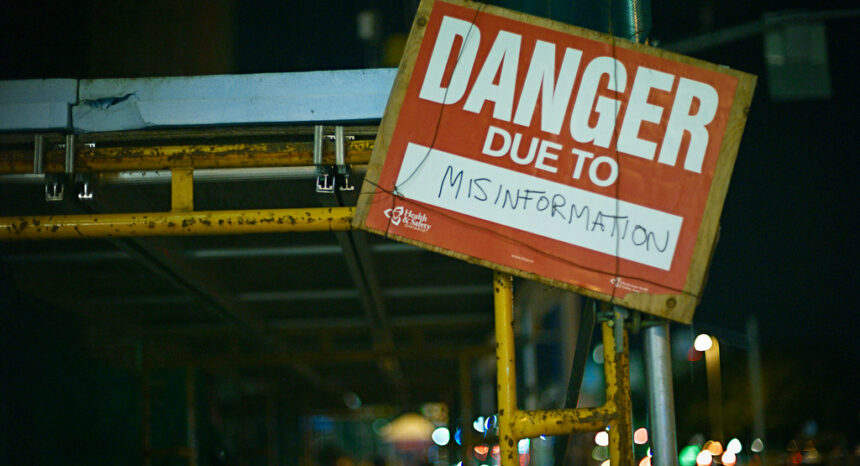In his new book, How America Lost Its Mind, Harvard Kennedy School professor Thomas Patterson charts the dramatic rise in misinformation over the past three decades. On everything from climate change to vaccines, millions of Americans hold views that are wildly at odds with the facts and are confounding efforts to deal with the nation’s policy problems.
Patterson, the founder of Journalist’s Resource, examines the forces that are misleading Americans and pitting them against each other: politicians for whom deception is a strategy; talk show hosts who have made an industry of outrage; foreign agents and social media operatives who spread disinformation to promote a cause, make a buck or simply amuse themselves.
Journalists are also part of the problem. Certain newsroom practices, Patterson notes, contribute to the dissemination of false or misleading information.
Drawing from large-scale, systematic studies conducted by the Columbia School of Journalism, Harvard’s Berkman-Klein Center for Internet & Society and other research organizations, he shows that many of the mistaken beliefs Americans hold originated with mainstream news outlets or were amplified by them. The Columbia study concluded that “news organizations play a major role in propagating hoaxes, false claims, questionable rumors, and dubious viral content.”
Below, Patterson offers journalists three tips on how to avoid being part of the misinformation problem as well as suggestions for what to do instead:
WHAT TO AVOID: False equivalences.

Journalists strive for fairness and balance. They aim to give each side in partisan debate a chance to make its case. It’s a sensible approach in many situations and protects journalists from accusations of bias. But, as Patterson notes, the approach breaks down when one side is engaged in lying or deception. Balanced reporting then devolves into what The Atlantic’s James Fallows calls “false equivalencies” — the side-by-side presentation of statements that differ wildly in their factual integrity.
“When a newsmaker tells a bold-faced lie, and the press reports it,” Patterson writes, “the press is complicit in the deception — the claim gets publicized and gains credibility from appearing in the news.”
HOW TO GET IT RIGHT:
If one side is making erroneous claims or twisting the facts, Patterson says that journalists should say so in their coverage. Make it clear when claims are demonstrably untrue. Patterson says that a failure to do so increases the likelihood that citizens will accept such claims as true.
WHAT TO AVOID: Thinly sourced, dubious claims.
Disinformation — deliberate falsehoods — and misinformation — mistaken beliefs — flow freely in today’s information system and invariably attract journalists’ attention. If they are heard often enough, Patterson notes, they can appear to be factual and get reported as such.
An example is the false claim that the 2010 Affordable Care Act included “death panels” — government-appointed commissions with the power to deny health care to elderly patients. A study published in Journalism showed that in the month after the claim arose the nation’s top 50 newspapers ran more than 700 articles on the allegation. In more than 60% of the stories, journalists made no effort to debunk the claim. In three-fourths of the stories where journalists challenged the claim, they did so without giving a reason. And in a third of the stories where they said the claim was false, proponents were given space to say it was true.
HOW TO GET IT RIGHT:
Journalists’ responsibility to their audience goes beyond the mere transmission of information. Journalists need to fact-check claims and tell audiences when a newsmaker persists in making false claims, even inadvertent ones. Patterson says that journalists have a gatekeeping responsibility that requires them to screen out, or at least call out, false claims.
WHAT TO AVOID: The publish-it-now impulse.
In today’s hyper-competitive media environment, there’s a temptation to rush publication, whether it’s a story about the latest sensational development or a tweet from President Donald Trump.
“Many of these developments are important and newsworthy, but they’re often a source of false claims,” Patterson says. “Withholding coverage can mean getting scooped or ignoring a story that others are reporting, but hyper-competition is not a justification for spreading misinformation or for disregarding journalistic canons.”
As journalists Bill Kovach and Tom Rosenstiel note in their book, The Elements of Journalism, “the discipline of verification is what separates journalism from entertainment, propaganda, fiction, or art.”
HOW TO GET IT RIGHT:
Patterson says the solution to this problem is straightforward. Journalists should only report information that’s been independently verified. That might mean publishing a brief piece initially and then adding to it as facts are checked.
For further reading:
Thomas E. Patterson, How America Lost Its Mind: The Assault on Reason That’s Crippling Our Democracy.
Yochai Benkler, Robert Faris and Hal Roberts, Network Propaganda: Manipulation, Disinformation, and Radicalization in American Politics.
Craig Silverman, “Lies, Damn Lies and Viral Content: How News Websites Spread (and Debunk) Online Rumors, Unverified Claims and Misinformation,” Tow Center for Digital Journalism, Columbia Journalism School.
Denise-Marie Ordway, “Fake News and the Spread of Misinformation: A Research Roundup,” Journalist’s Resource.
Chloe Reichel, “Covering Health Research? Choose Your Studies (and Words) Wisely,” Journalist’s Resource.
This image was obtained from the Flickr account of 3dpete and is being used under a Creative Commons license. No changes were made.


Expert Commentary